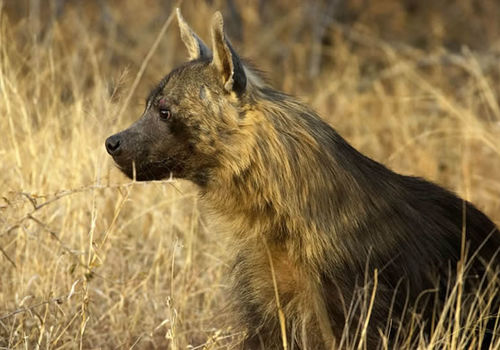
Brown hyena
Hyaena brunneaBrown hyena
Introduction: The brown hyena (Hyaena brunnea) is the mammal famous for its weird howl, which resembles a hysterical human laugh. The name is descriptive of their general dark brown colour. It has a typical hyena profile of appearing higher at the shoulders than at the rump. It has a massive head, neck and shoulders, the extra weight being borne by larger fore feet than the hind. They have powerful jaws and strong teeth that enable them to crush and eat even large bones. They are poor killers, confining their kill to small prey - even occasional attempts at springbok are generally unsuccessful. It is highly unlikely that they could tackle prey the size of kudu, waterbuck or zebra. Individuals are known to kill sheep, goats and calves.
Brown hyena steer clear of lions or their kills, but have no trouble appropriating the kills from cheetah and have been known to steal from leopards. The African wild dog will drive them off carcasses and their greatest rivals for food are black-backed jackals.
Distribution: Brown hyenas can be found in central parts of Namibia, as far north as Etosha National Park and southwards in the coastal Namib Desert, scavenging along open beaches, where carrion is often washed ashore.
Diet: Brown hyena are predominately scavengers but their diet also includes a wide range of small mammals, birds, reptiles, fruit and insects. Water is not an essential requirement as is the case with the spotted hyena, as they can rely on the moisture from their food. This gives them a distinct advantage when water may not be available for long periods of the year, Under these circumstances, they make use of tsamma melons and gemsbok cucumbers to fulfil their water requirements.
Colouring: Coarse blackish-grey coat and stripes only on its legs. The overall colour can vary due to age or various stages of moult, from a very dark brown to almost black in some specimens.
Breeding: The young are born in dens in litters of 1 or 2. Cubs are born with their eyes closed, opening after 14 days. All members of the group visit the dens and it is has been known for individuals to carry large chunks of domestic animals from a distance of up to 15km.
Size: Adult males stand around 80cm at the shoulder, 74cm at the rear. The males average 47kg and the females, slightly less in shoulder height, lighter at 42kg.
Become a citizen scientist & contribute to the long-term survival of Namibia's wild carnivores by logging your sightings on the Carnivore Tracker App
Klein Windhoek

